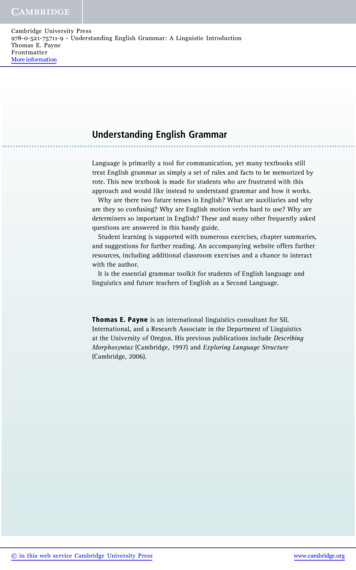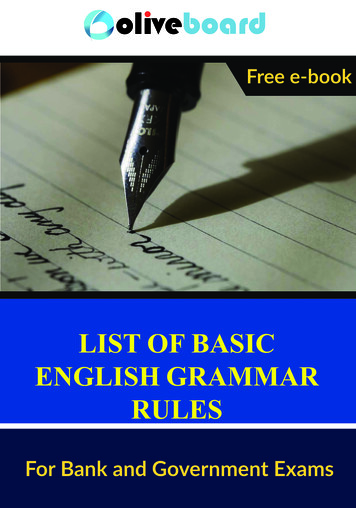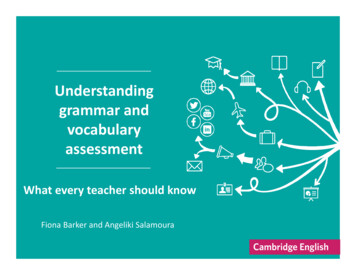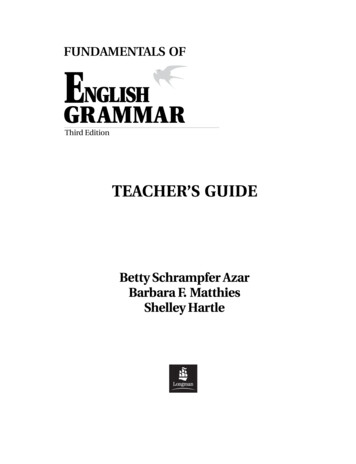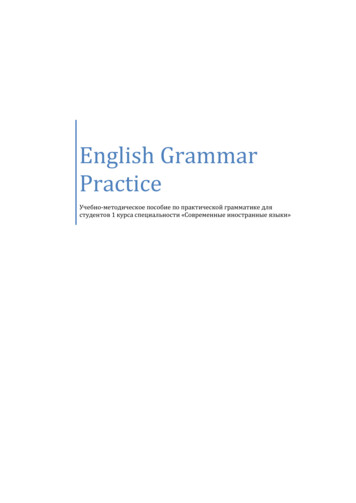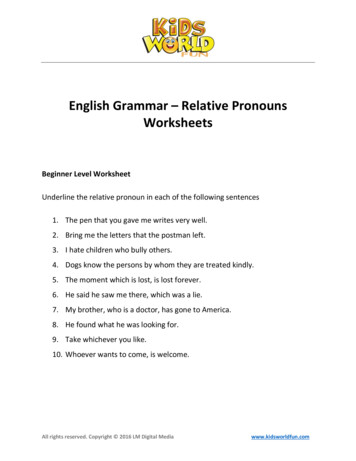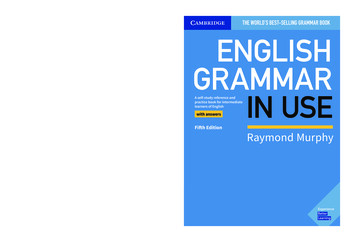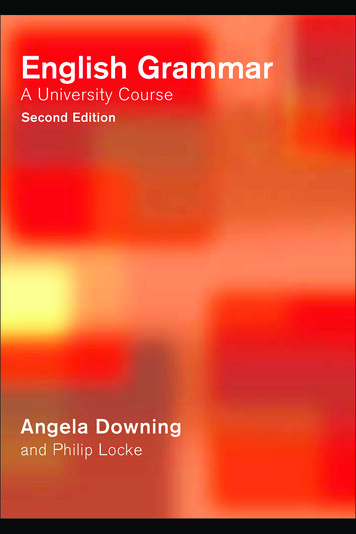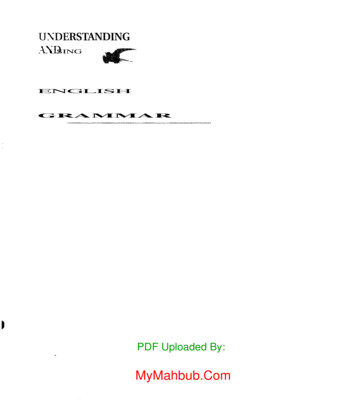
Transcription
UNDERSTANDINGAND USING * ». „ENGLISHGRAMMARPDF Uploaded By:MyMahbub.Com
UNDERSTANDINGANDUSINGNGLISHGRAMMARThird EditionBetty Schrampfer Azar
Azar, Betty SchrampferUnderstanding and using English grammar / Betty Schrampfer Azar- - 3rd ed.p. cm.Includes index.ISBNO-13-958661-X1. English language—Textbooks for foreign speakers. 2. Englishlanguage—Grammar—Problems, exercises, etc. I. Title.PE1128.A97 199897-47425428.2'4- -dc21CIPPublisher: Mary Jane PelusoDevelopment Editor: Janet JohnstonAVP/Director of Production and Manufacturing: Aliza GreenblattExecutive Managing Editor: Dominick MoscoManaging Editor: Shelley HartleElectronic Production Editors: Christine Mann, Rachel BaumannElectronic Art Production Supervisor: Ken LiaoElectronic Publishing Specialist: Steven GreydanusArt Director: Merle KrumperCover & Interior Design: Eric DawsonManufacturing Manager: Ray KeatingIllustrator: Don Martinetti 1999 by Betty Schrampfer AzarPublished by Pearson Education10 Bank Street, White Plains, NY 10606All rights reserved. No part of this book may bereproduced, in any form or by any means, withoutpermission in writing from the publisher.Printed with Corrections, July 1999Printed in the United States of America10O-lB-TSfibbl-X
In memoriamTo my wonderful parents,Frances Nies SchrampferandWilliam H. Schrampfer,who set me on my path.
CONTENTSPREFACE TO THE THIRD EDITIONxiiiACKNOWLEDGMENTSxvChapter 1OVERVIEW OF VERB TENSES1-1 THE SIMPLETENSES1-2 THE PROGRESSIVE TENSES1-3 THE PERFECT TENSES1-4 THE PERFECT PROGRESSIVE TENSES1-5 SUMMARY CHART OFVERBTENSES1-6 SPELLING OF -ING AND -ED FORMSChapter 2PRESENT AND PAST, SIMPLE AND Chapter 3SIMPLE PRESENTPRESENT PROGRESSIVESTATIVEVERBSAM/IS/ARE BEING ADJECTIVEREGULAR AND IRREGULAR VERBSREGULAR VERBS: PRONUNCIATION OF -ED ENDINGSIRREGULAR VERBS: AN ALPHABETICAL LISTTROUBLESOME VERBS: RAISE/RISE, SET/SIT, LAY/LIESIMPLE PASTPAST PROGRESSIVEUSING PROGRESSF/E VERBS WITH ALWAYS TO COMPLAINUSING EXPRESSIONS OF PLACE WITH PROGRESSIVE VERBS131315171920222627283031PERFECT AND PERFECT PROGRESSIVE TENSES3-13-23-33-4Chapter 42345610PRESENT PERFECTPRESENT PERFECT PROGRESSIVEPAST PERFECTPAST PERFECT PROGRESSIVE36424547FUTURE TIME4-14-24-34-4SIMPLE FUTURE: WILL AND BE GOINGTOWILL vs. BE GOINGTOEXPRESSING THE FUTURE INTIME CLAUSESUSING THE PRESENT PROGRESSIVE AND THE SIMPLE PRESENTTO EXPRESS FUTURE TIME4-5 FUTURE PROGRESSIVE4-6 FUTURE PERFECT4-7 FUTURE PERFECT PROGRESSIVE51525557606262VII
:;: co : -I . 53 CLAUSES OF TIME AND REVIEW OF VERB TENSES5-1 ADVERB CLAUSES OFTIME: FORM5-2 USING ADVERB CLAUSES TO SHOWTIME RELATIONSHIPS7072Chapter 6 SUBJECT-VERB AGREEMENT6-1 FINAL -S/-ES: USE, PRONUNCIATION, AND SPELLING6-2 BASIC SUBJECT-VERB AGREEMENT6-3 SUBJECT-VERB AGREEMENT: USING EXPRESSIONS OF QUANTITY6-4 SUBJECT-VERB AGREEMENT: USING THERE BE6-5 SUBJECT-VERB AGREEMENT: SOME IRREGULARITIES84888990. . . 92Chapter? GULARAND IRREGULAR PLURAL NOUNSPOSSESSIVE NOUNSUSING NOUNS AS MODIFIERSCOUNT AND NONCOUNT NOUNSNONCOUNT NOUNSSOME COMMON NONCOUNT NOUNSBASIC ARTICLE USAGEGENERAL GUIDELINES FOR ARTICLE USAGEEXPRESSIONS OF QUANTITYUSING A FEW AND FEW; A LITTLE AND LITTLEUSING OF IN EXPRESSIONS OF QUANTITYALL (OF) AND BOTH (OF)SINGULAR EXPRESSIONS OF QUANTITY: ONE, EACH, rs PRONOUNS8-1 PERSONAL PRONOUNS8-2 PERSONAL PRONOUNS: AGREEMENT WITH GENERIC NOUNS ANDINDEFINITE PRONOUNS8-3 PERSONAL PRONOUNS: AGREEMENT WITH COLLECTIVE NOUNS8-4 REFLEXIVE PRONOUNS8-5 USING YOU, ONE, AND THEY AS IMPERSONAL PRONOUNS8-6 FORMS OF OTHER8-7 COMMON EXPRESSIONS WITH OTHER132134136138140142145Chapter 9 MODALS, PART 19-1 INTRODUCTION9-2 POLITE QUESTIONS WITH /ASTHE SUBJECT9-3 POLITE QUESTIONS WITH YOU ASTHE SUBJECT9-4 POLITE REQUESTS WITH WOULD YOU MIND9-5 EXPRESSING NECESSITY: MUST, HAVE TO, HAVE GOT TO9-6 LACK OF NECESSITY AND PROHIBITION: HAVE TO AND MUSTINTHE NEGATIVE9-7 ADVISABILITY: SHOULD, OUGHTTO, HAD BETTER9-8 THE PAST FORM OF SHOULD9-9 EXPECTATIONS: BE SUPPOSED TO9-10 MAKING SUGGESTIONS: LET'S, WHY DON'T, SHALL I/WE9-11 MAKING SUGGESTIONS: COULDvs. SHOULDVlii CONTENTS151152152153157158160163166169171
Chapter 10MODALS, PART 210-110-210-310-410-510-610-710-810-910-10Chapter 11DEGREES OF CERTAINTY: PRESENTTIMEDEGREES OF CERTAINTY: PRESENTTIME NEGATIVEDEGREES OF CERTAINTY: PASTTIME,DEGREES OF CERTAINTY: FUTURETIMEPROGRESSIVE FORMS OF MODALSABILITY: CAN AND COULDUSING WOULDTO EXPRESS A REPEATED ACTION IN THE PASTEXPRESSING PREFERENCE: WOULD RATHERCOMBINING MODALS WITH PHRASAL MODALSSUMMARY CHART OF MODALS AND SIMILAR EXPRESSIONS176178181184188193195197198199THE PASSIVE11-1 FORMINGTHE PASSIVE11-2 USING THE PASSIVE11-3 INDIRECT OBJECTS USED AS PASSIVE SUBJECTS11-4 THE PASSIVE FORM OF MODALS AND PHRASAL MODALS11-5 STATIVE PASSIVE11-6 COMMON STATIVp PASSIVE VERBS PREPOSITIONS11-7 THE PASSIVE WITH GET11-8 PARTICIPIAL ADJECTIVES208211213218225228232235Chapter 12 NOUN CLAUSES12-1 INTRODUCTION12-2 NOUN CLAUSES BEGINNING WITH A QUESTION WORD12-3 NOUN CLAUSES BEGINNING WITH WHETHER OR IF12-4 QUESTION WORDS FOLLOWED BY INFINITIVES12-5 NOUN CLAUSES'BEGINNING WITH THAT12-6 QUOTED SPEECH12-7 REPORTED SPEECH: VERB FORMS IN NOUN CLAUSES12-8 USING THE SUBJUNCTIVE IN NOUN CLAUSES12-9 USING -EVER WORDSChapter 13239240245247248251254263265ADJECTIVE -1113-1213-1313-1413-15INTRODUCTIONADJECTIVE CLAUSE PRONOUNS USED AS THE SUBJECTADJECTIVE CLAUSE PRONOUNS USED AS THE OBJECT OF A VERBADJECTIVE CLAUSE PRONOUNS USED AS THE OBJECT OFA PREPOSITIONUSUAL PATTERNS OF ADJECTIVE CLAUSESUSING WHOSEUSING WHERE IN ADJECTIVE CLAUSESUSING WHEN IN ADJECTIVE CLAUSESUSING ADJECTIVE CLAUSES TO MODIFY PRONOUNSPUNCTUATING ADJECTIVE CLAUSESUSING EXPRESSIONS OF QUANTITY IN ADJECTIVE CLAUSESUSING NOUN OFWHICHUSING WHICH TO MODIFY AWHOLE SENTENCEREDUCING ADJECTIVE CLAUSES TO ADJECTIVEPHRASES: INTRODUCTIONCHANGING AN ADJECTIVE CLAUSE TO AN ADJECTIVE 0CONTENTS JX
Chapter 14 GERUNDS AND INFINITIVES, PART pter 15GERUNDS: INTRODUCTIONUSING GERUNDS AS THE OBJECTS OF PREPOSITIONSCOMMON PREPOSITION COMBINATIONS FOLLOWED BY GERUNDSCOMMONVERBS FOLLOWED BY GERUNDSGO GERUNDSPECIAL EXPRESSIONS FOLLOWED BY -INGCOMMONVERBS FOLLOWED BY INFINITIVESCOMMONVERBS FOLLOWED BY EITHER INFINITIVES OR GERUNDSREFERENCE LIST OF VERBS FOLLOWED BY GERUNDSREFERENCE LIST OF VERBS FOLLOWED BY INFINITIVESIT INFINITIVE; GERUNDS AND INFINITIVES AS SUBJECTS297298299302303304307311318319323GERUNDS AND INFINITIVES, PART 215-115-215-315-415-515-615-7J5-815-9INFINITIVE OF PURPOSE: IN ORDER TOADJECTIVES FOLLOWED BY INFINITIVESUSING INFINITIVES WITH TOO AND ENOUGHPASSIVE AND PAST FORMS OF INFINITIVES AND GERUNDSUSING GERUNDS OR PASSIVE INFINITIVES FOLLOWING NEEDUSING A POSSESSIVE TO MODIFY A GERUNDUSING VERBS OF PERCEPTIONUSING THE SIMPLE FORM AFTER LFTAND HELPUSING CAUSATIVE VERBS: MAKE, HAVE, GET326328330331333334336338339Chapter 16 COORDINATING CONJUNCTIONS16-116-2PARALLEL STRUCTUREUSING PAIRED CONJUNCTIONS: BOTH. AND; NOT ONLY.BUT ALSO; EITHER .,. QR; NEITHER . NOR16-3 COMBINING INDEPENDENT CLAUSES WITH COORDINATINGCONJUNCTIONS348353355Chapter 17 ADVERB CLAUSES17-1 INTRODUCTION17-2 USING ADVERB CLAUSES TO SHOW CAUSE AND EFFECT17-3 EXPRESSING CONTRAST (UNEXPECTED RESULT):USING EVENTHOUGH17-4 SHOWING DIRECT CONTRAST: WHILE AND WHEREAS17-5 EXPRESSING CONDITIONS IN ADVERB CLAUSES: /F-CLAUSES17-6 ADVERB CLAUSES OF CONDITION: USING WHETHER OR NOTAND EVEN IF17-7 ADVERB CLAUSES OF CONDITION: USING IN CASE ANDINTHE EVENTTHAT17-8 ADVERB CLAUSES OF CONDITION: USING UNLESS17-9 ADVERB CLAUSES OF CONDITION: USING ONLY IFChapter 18363366367368369370371REDUCTION OF ADVERB CLAUSES TO MODIFYINGADVERBIAL PHRASES18-1 INTRODUCTION18-2 CHANGING TIME CLAUSES TO MODIFYING ADVpRBIAL PHRASES18-3 EXPRESSING THE IDEA OF "DURING THE SAME TIME"IN MODIFYING ADVERBIAL PHRASES18-4 EXPRESSING CAUSE AND EFFECT IN MODIFYINGADVERBIAL PHRASES18-5 USING UPON -ING IN MODIFYING ADVERBIAL PHRASESX CONTENTS359362374375376376380
I - a Dter 19CONNECTIVES THAT EXPRESS CAUSE AND EFFECT,CONTRAST, AND CONDITION19-1 USING BECAUSE OF AND DUETO19-2 USING TRANSITIONS TO SHOW CAUSE AND EFFECT:THEREFORE AND CONSEQUENTLY19-3 SUMMARY OF PATTERNS AND PUNCTUATION19-4 OTHER WAYS OF EXPRESSING CAUSE AND EFFECT:SUCH. THAT AND SO. THAT19-5 EXPRESSING PURPOSE: USING SO THAT.19-6 SHOWING CONTRAST (UNEXPECTED RESULT)19-7 SHOWING DIRECT CONTRAST19-8 EXPRESSING CONDITIONS: USING OTHERWISE AND OR (ELSE)19-9 SUMMARY OF CONNECTIVES: CAUSE AND EFFECT, CONTRAST,CONDITION:napter 20385387389391393395398401402CONDITIONAL SENTENCES AND WISHES20-1 OVERVIEW OF BASIC VERB FORMS USED INCONDITIONAL SENTENCES20-2 TRUE INTHE PRESENT OR FUTURE20-3 UNTRUE (CONTRARYTO FACT) INTHE PRESENT OR FUTURE20-4 UNTRUE (CONTRARYTO FACT) INTHE PAST20-5 USING PROGRESSIVE VERB FORMS IN CONDITIONAL SENTENCES20-6 USING "MIXED TIME" IN CONDITIONAL SENTENCES20-7 OMITTING IF20-8 IMPLIED CONDITIONS20-9 USING AS IF/AS THOUGH20-10 VERB FORMS FOLLOWING WISH20-11 USING WOULDTO MAKE WISHES ABOUTTHE FUTUREAppendix SUPPLEMENTARY GRAMMAR UNITSUnit A: BASIC GRAMMAR TERMINOLOGYA-l SUBJECTS, VERBS, AND OBJECTSA-2 PREPOSITIONS AND PREPOSITIONAL PHRASESA-3 ADJECTIVESA-4 ADVERBSA-5 THEVERB BEA-6 LINKING VERBSUnit B: QUESTIONSB-l FORMS OF YES/NO AND INFORMATION QUESTIONSB-2 QUESTION WORDSB-3 SHORTENED YES/NO QUESTIONSB-4 NEGATIVE QUESTIONSB-5 TAG QUESTIONSUnit C: CONTRACTIONSUnitD: NEGATIVESD-l USING NOT AND OTHER NEGATWE WORDSD-2 AVOIDING DOUBLE NEGATIVESD-3 BEGINNING A SENTENCE WITH A NEGATIVE WORDUnit E: PREPOSITION COMBINATIONSEPREPOSITION COMBINATIONS WITH ADJECTIVES AND VERBSUnit F: CONNECTIVES TO GIVE EXAMPLES AND TO CONTINUE AN IDEAF-l CONNECTIVESTO GIVE EXAMPLESF-2 CONNECTIVESTO CONTINUETHE SAME IDEAUnit G: VERB FORM REVIEW EXERCISESINDEX.-413414415418. . . 18A20A20A21A24A26A26INDEX 1CONTENTS Xi
Preface to theThird EditionUnderstanding and Using English Grammar is a developmental skills text for intermediate toadvanced students of English as a second or foreign language. While focusing ongrammar, it promotes the development of all language skills in a variety of ways. Itfunctions principally as a classroom teaching text but also serves as a comprehensivereference text for students.The eclectic approach and abundant variety of exercise material remain the same as inthe earlier editions, but each new edition incorporates new ways and means. In particular: The communicative aspects of Understanding and Using English Grammar are morefully developed and explicit in the third edition. There are numerous "realcommunication" opportunities for the teacher to exploit. The text often uses thestudents' own life experiences as context and regularly introduces topics of interestto stimulate the free expression of ideas in structured as well as open discussions.The text supports the view of many experienced teachers that grammar-based andcommunicative approaches are not mutually exclusive, but rather mutuallysupportive, and can advantageously co-exist in the same language program, even inthe same class, even in the same lesson. Similarly, the interactive aspects of the text receive greater emphasis in the thirdedition. Many of the exercises formerly designated ORAL or ORAL (BOOKS CLOSED)are now reformatted to be more clearly available for pair work or group work, inaddition to still being viable as class work led by a teacher. This edition encouragesinteractivity but leaves it open for the users to decide what degree of interactivitybest suits their needs. There is now an even wider variety of exercise types. This edition has a largernumber of free-response exercises and open-ended communicative tasks, while stillproviding ample controlled-response exercises to aid initial understanding of theform, meaning, and usage of the target structures. It also includes more writingtopics, more speaking activities, expanded error analysis exercises, and additionalextended-context exercises. Long chapters have been broken into shorter units, and certain grammar units havebeen reorganized.The bird soaring upward and forward on the cover of this new edition is a swallow.Found throughout the world, swallows are joyful, playful, energetic birds whose comingsand goings announce changes in the seasons. Like the butterfly on the second edition, theswallow on this edition signals new beginnings—as student, teacher, and text writer cometogether in our shared journey toward the learning of a new language.xiii
Understanding and Using English Grammar is accompanied by a Workbook, consisting principally of selfstudy exercises for independent work. a Chartbook, a reference book consisting of only the grammar charts. an Answer Key, with the answers to the exercises. a Teacher's Guide, with teaching suggestions and additional notes on grammar, aswell as the answers to the exercises.The Azar Grammar Series consists of Understanding and Using English Grammar (blue cover) for upper-level students. Fundamentals of English Grammar (black) for mid-level students. Basic English Grammar (red) for lower or beginning levels.Supplementary works by other authors Fun with Grammar, a teacher resource text by Suzanne Woodward Azar Interactive, a CD-ROM program by Howard Beckermanwin
AcknowledgmentsThe second edition of UUEG was thoroughly reviewed by twenty-five ESL/EFL professionals.Their reviews were outstandingly helpful in their insights and suggestions. I studied thereviews with great care, and they greatly influenced the revision in matters large and small.I could not, unfortunately, make every change and addition that every reviewer sought (notwithout writing a 1000-page book—which my publisher would definitely frown upon!). Iwish to express my heartfelt thanks for the
GRAMMAR. PDF Uploaded By: MyMahbub.Com. UNDERSTANDING AND USING NGLISH GRAMMAR Third Edition Betty Schrampfer Azar. Azar, Betty Schrampfer Understanding and
